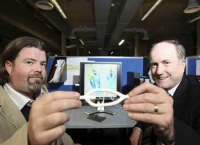The Prolong AV graft, recently granted a US patent, aims to significantly reduce the chance of failure within the first two years.
UL researchers Prof Tim McGloughlin and Dr Michael Walsh are co-inventors of the Prolong AV graft along with Prof Pierce Grace, consultant vascular surgeon at the Mid-Western Regional Hospital and Adjunct Professor of Surgical Science at UL.
Prof Tim McGloughlin said: ‘I am confident that the design features of the Prolong AV graft would lead to substantially superior performance compared to the grafts currently used.’
Dialysis access is necessary in patients with End Stage Renal Disease. These patients require dialysis, a process by which the blood is cleaned in a machine external to the body. The process requires access to the circulating blood and this is usually done in the forearm where blood is taken from the arm, passed through the dialysis machine and returned to the circulation again through the arm.
Taking the blood from the arm requires a surgical procedure where a short circuit is created between the arterial blood vessels and the venous blood vessels. This short circuit has several forms and the invention addresses the problems encountered when creating this short circuit using a graft.
Such grafts have a functioning life of less than two years in half the cases that they are used. Most of the problems occur where the flow from the artery enters the vein, with disease forming in the junction area leading to blocking of the graft.
The Prolong AV graft aims to eliminate the formation of disease at the venous junction. Dr Michael Walsh, who is leading the project at the university, said: ‘There is significant potential benefit to patients if the functioning life of grafts used for dialysis access can be prolonged, reducing the number of revision surgeries.’
The Prolong AV graft is currently undergoing pre-clinical trials in the US. The design features of this graft include splitting of the flow within the graft and rejoining the flow at the venous junction in an opposing fashion. This ensures that the flow entering the vein hits off itself creating self-correcting flow patterns. The flow moves through the vein with significantly reduced wall shear stresses, the friction forces implicated in the disease formation process.
Prof Pierce Grace said: ‘Once the concept of the novel device is proven in the dialysis access application, the device will have further applications in peripheral bypass surgery, a procedure where blood flow is restored to a limb with a blocked artery that if left untreated would lead to limb amputation.’

Dr Michael Walsh and Prof Tim McGloughlin, UL researchers with a model of the Prolong AV graft. Recently granted a US patent, the graft aims to significantly reduce the chance of failure within the first two years





Project to investigate hybrid approach to titanium manufacturing
What is this a hybrid of? Superplastic forming tends to be performed slowly as otherwise the behaviour is the hot creep that typifies hot...